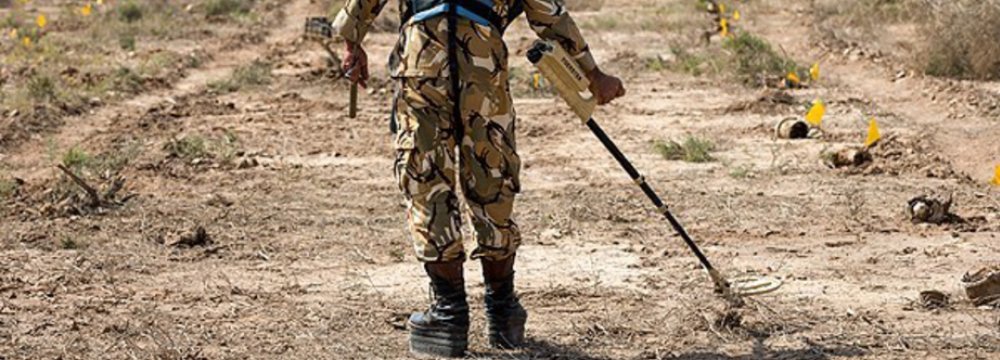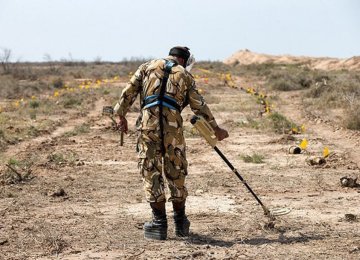An explosion on Saturday nearby the Borj-e-Ahmadi District in Qasr-e Shirin County in the western part of Kermanshah Province, “was part of landmine clearing operations,” said Faramarz Akbari, the county governor, allaying people’s concerns over the blasts.
During the operations, all the landmines collected were neutralized and destroyed, he said, referring to the decades of finding and clearing the dangerous explosives left behind from the 1980-88 Iraq-Iran war, IRNA reported.
“Our teams have completed clearing operations for landmines planted on the ground surface and are now working to unearth those buried underneath,” he said, implying that some of the landmines may have “shifted in the recent floods.” Landmines could also be buried deep underground.
At present, two landmine clearing companies, affiliated to the Ministry of Defense, with nine teams of 30 experts are combing mine-ridden areas in the western city.
“Since the beginning of the current year (started March 21), seven landmine explosions in the Kurdish border city have led to three injuries and killed 18 livestock. The blasts also damaged agricultural machinery,” Akbari said.
“Last year, 20 landmine explosions in Qasr-e Shirin killed one person and injured 12 others,” he said, adding that so far several military personnel, farmers, villagers and nomads as well as members of the explosives clearing team have been killed or maimed in the explosions.
In February 2013, authorities celebrated the clearing of 700 hectares in the province including Qasr-e Shirin. However, landmines continue to take toll in the border areas. Currently, 27,000 people live in Qasr-e Shirin which has a 186-kilometer common border with Iraq.
Polluted Areas
Iran has been ranked in a number of global reports as the world’s second most mine-polluted country. Landmine and unexploded ordnance contamination in the western and southwest regions are the legacy of the Iraq-imposed war. Nearly 40 million mines were planted during the conflagration on both sides.
With the help of experts, more than 24 million mines have been detected and defused so far and 16 million are undetected, according to UN reports.
Unfortunately, decades after the 8-year military hostilities ended mines still kill and maim people living near the western borders
About 16-20 million of the landmines are believed to have been planted in Iran in over four million hectares in five provinces of West Azarbaijan, Kermanshah, Kurdestan, Ilam and Khuzestan during the war that killed one million people on both sides. Khuzestan is reportedly the most mined area.
The Iran Mine Action Center affiliated to Ministry of Defense estimates that 70,000 hectares are still infested with Iraqi landmines. The undetected land mines have severely restricted agricultural production and other activities in the five provinces along the Iraqi border.
Last year mine explosions killed 18 and injured 37 people across the country. One of those killed was a six-year-old girl living in a village considered mine-free in Susangerd, Khuzestan Province.
The explosion occurred when she was playing outside her home before going to school. “We never knew our lives were at risk. We were told that the village is mine-free,” her family said after the child died.
According to experts, mines get shifted in floodwaters and end up in areas previously considered clear and safe.
In addition to human deaths and injuries, land mines cause serious loss to agriculture by killing livestock and damaging agricultural machinery.
Mine sweeping and demarcation of mine fields are expensive and time-consuming procedures, requiring huge funding and sophisticated equipment, costing between $300 and $1000 to clear a single mine.






Add new comment
Read our comment policy before posting your viewpoints